4.2 Phobias
BETWEEN THE LINES
Famous People, Famous Fears
| Adele | Seagulls |
| Rihanna | Fish |
| Justin Bieber | Elevators, enclosed places |
| Aretha Franklin | Air travel |
| Kristen Stewart | Public speaking |
| Johnny Depp | Clowns, spiders, ghosts |
| Jennifer Aniston | Air travel |
| Justin Timberlake | Snakes |
| Keanu Reeves | Darkness |
| Scarlett Johansson | Cockroaches |
| Miley Cyrus | Spiders |
| Nicole Kidman | Butterflies |
| Madonna | Thunder |
phobia A persistent and unreasonable fear of a particular object, activity, or situation.
A phobia (from the Greek word for “fear”) is a persistent and unreasonable fear of a particular object, activity, or situation. People with a phobia become fearful if they even think about the object or situation they dread, but they usually remain comfortable as long as they avoid it or thoughts about it.
We all have our areas of special fear, and it is normal for some things to upset us more than other things (see MediaSpeak below). How do such common fears differ from phobias? DSM-
Most phobias technically fall under the category of specific phobias, DSM-
Specific Phobias
specific phobia A severe and persistent fear of a specific object or situation.
A specific phobia is a persistent fear of a specific object or situation (see Table 4.4). When sufferers are exposed to the object or situation, they typically experience immediate fear. Common specific phobias are intense fears of specific animals or insects, heights, enclosed spaces, thunderstorms, and blood. Here Andrew talks about his phobic fear of flying:
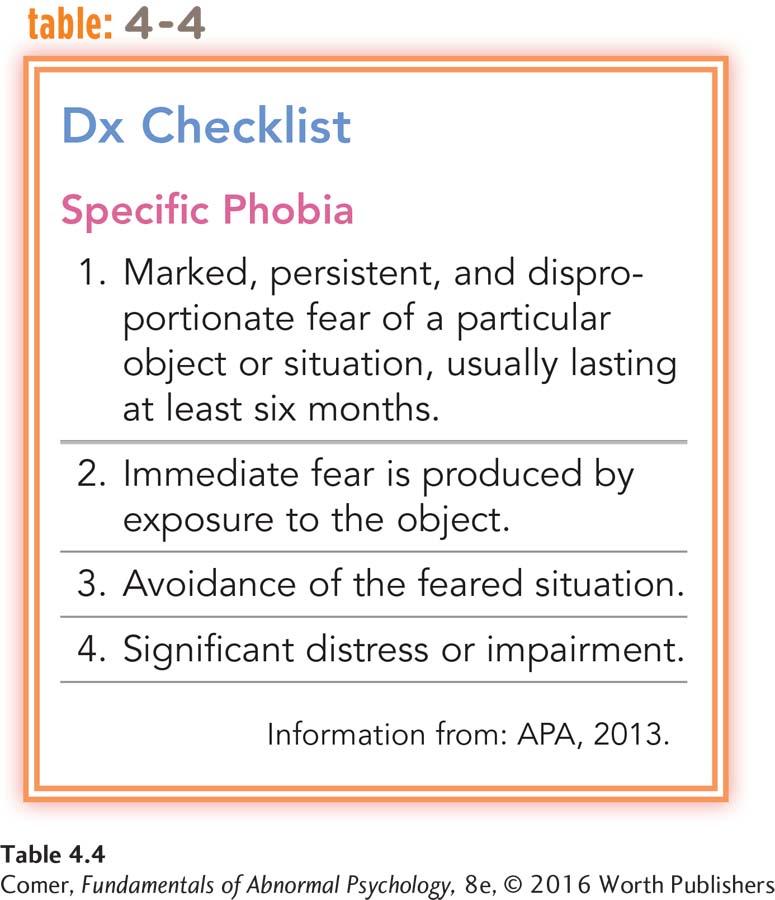
We got on board, and then there was the take-
(Melville, 1978, p. 59)
Each year around 12 percent of all people in the United States have the symptoms of a specific phobia (Kessler et al., 2012). Almost 14 percent of individuals develop such phobias at some point during their lives, and many people have more than one at a time. Women with the disorder outnumber men by at least 2 to 1. For reasons that are not clear, the prevalence of specific phobias also differs among racial and ethnic minority groups. In some studies, African Americans and Hispanic Americans report having at least 50 percent more specific phobias than do white Americans, even when economic factors, education, and age are held steady across the groups (Stein & Williams, 2010; Breslau et al., 2006). It is worth noting, however, that these heightened rates are at work only among African and Hispanic Americans who were born in the United States, not those who emigrated to the United States at some point during their lives (Hopko et al., 2008).
The impact of a specific phobia on a person’s life depends on what arouses the fear (Costa et al., 2014). People whose phobias center on dogs, insects, or water will keep encountering the objects they dread. Their efforts to avoid them must be elaborate and may greatly restrict their activities. Urban residents with snake phobias have a much easier time. The vast majority of people with a specific phobia do not seek treatment (NIMH, 2011). They try instead to avoid the objects they fear.
Agoraphobia
agoraphobia An anxiety disorder in which a person is afraid to be in public situations from which escape might be difficult or help unavailable if paniclike or embarrassing symptoms were to occur.
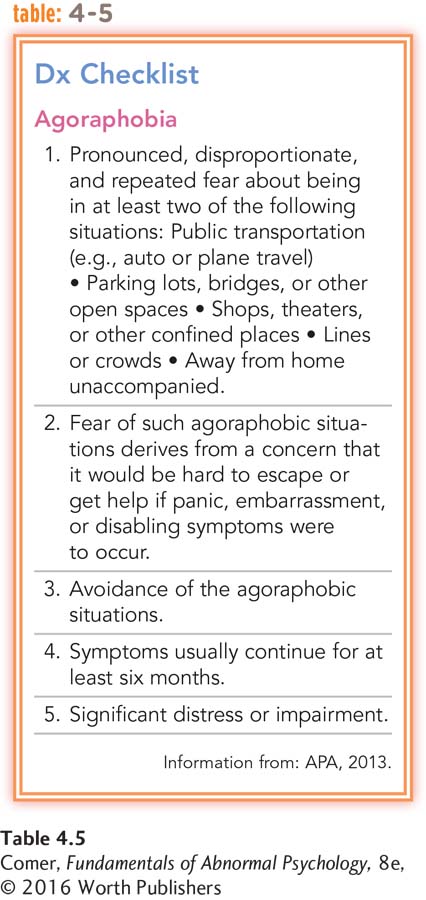
People with agoraphobia are afraid of being in public places or situations where escape might be difficult or help unavailable, should they experience panic or become incapacitated (APA, 2013) (see Table 4.5 at right). This is a pervasive and complex phobia, which usually begins in one’s twenties or thirties. In any given year, 1.7 percent of the population experience agoraphobia, women twice as frequently as men (Kessler et al., 2012). The disorder also is twice as common among poor people as wealthy people (Sareen et al., 2011). At least one-
It is typical of people with agoraphobia to avoid entering crowded streets or stores, driving in parking lots or on bridges, and traveling on public transportation or in airplanes. If they venture out of the house at all, it is usually only in the company of close relatives or friends. Some insist that family members or friends stay with them at home, but even at home and in the company of others they may continue to feel anxious.
In many cases the intensity of the agoraphobia fluctuates. In severe cases, people become virtual prisoners in their own homes. Their social life dwindles and they cannot hold a job. People with agoraphobia may also become depressed, sometimes as a result of the severe limitations that their disorder places on their lives.
Many people with agoraphobia do, in fact, have extreme and sudden explosions of fear, called panic attacks, when they enter public places, a problem that may have first set the stage for their development of agoraphobia. Such individuals may receive two diagnoses—
MediaSpeak
The Fear Business
By Beth Accomando, NPR, October 6, 2013
Every job requires a special skill set.
In this business, screaming is one of those skills. Also, being certified on a chainsaw.
“We’re always looking for folks who have a passion for wielding a chainsaw while wearing makeup and costume and just scaring the heck out of people,” says Jennifer Struever.
Streuver is the event manager for Scream Zone at the Del Mar Fairgrounds in San Diego County, Calif. Haunted houses are part of the multibillion-
Streuver is conducting interviews inside the Scream Zone’s tented maze, in a room that could be Leatherface’s kitchen. It has a slab of meat hanging from the ceiling and impressive cutlery on the wall.
“We do ask people if they have any problem with chainsaw fumes, moving floors, strobe lights, loud noises,” Streuver says. “We need to know if they’re allergic to stage blood or latex, because they will be experiencing that in their costumes and makeup.”
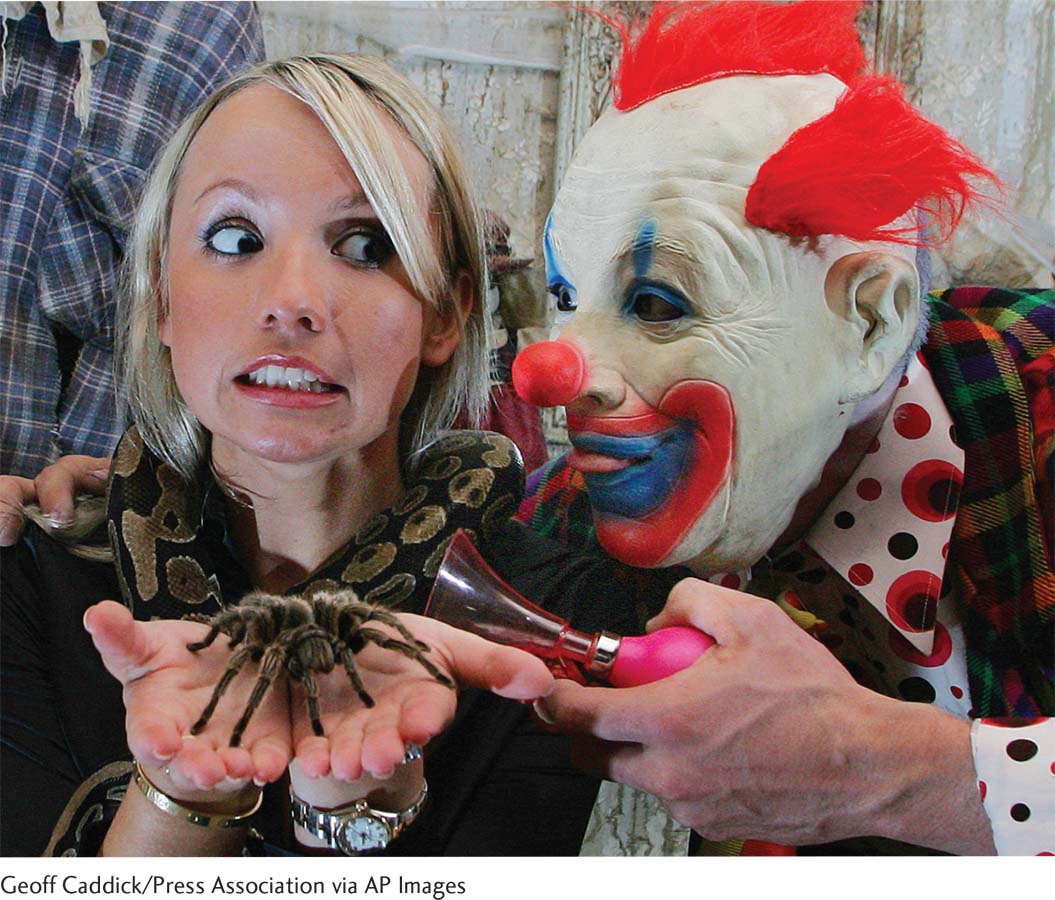
Over at the haunted castle end of the Scream Zone tent, a huge green demon salivates over potential victims—
Geraldo Figueroa could get into that. “I’d like to be a zombie,” he says. “It seems like it’d be really fun, especially with the new attraction”—zombie paintball safari….
….ung power [is important]—as Samantha Topacio demonstrates. “I mean, I haven’t screamed in awhile because no one really recreationally screams just for fun,” she says. Topacio performed better at her audition. “I did one that was a victim-
“It is so awesome to see big burly men crumble to the ground,” she says. “You think they’re so tough. They come in like, ‘Oh, you’re just a girl, please.’ And they just crumble. They will run out of this and say, ‘Oh, blank, no, I’m out of here.’”
Each time someone flees for an emergency exit, it’s a bloody feather in her co-
“The Fear Business.” Source: “In This Business, Scaredy Cats Need Not Apply,” by Beth Accomando, NPR, October 6, 2013 (from KPBS).
What Causes Phobias?
Each of the models offers explanations for phobias. Evidence tends to support the behavioral explanations. Behaviorists believe that people with phobias first learn to fear certain objects, situations, or events through conditioning (Cherry, 2014; Field & Purkis, 2012). Once the fears are acquired, the individuals avoid the dreaded object or situation, permitting the fears to become all the more entrenched.
classical conditioning A process of learning in which two events that repeatedly occur close together in time become tied together in a person’s mind and so produce the same response.
Behavioral Explanations: How Are Fears Learned? Behaviorists propose classical conditioning as a common way of acquiring phobic reactions. Here, two events that occur close together in time become strongly associated in a person’s mind, and, as you saw in Chapter 2, the person then reacts similarly to both of them. If one event triggers a fear response, the other may also.
In the 1920s, a clinician described the case of a young woman who apparently acquired a specific phobia of running water through classical conditioning (Bagby, 1922). When she was 7 years old she went on a picnic with her mother and aunt and ran off by herself into the woods after lunch. While she was climbing over some large rocks, her feet were caught between two of them. The harder she tried to free herself, the more trapped she became. No one heard her screams, and she grew more and more terrified. In the language of behaviorists, the entrapment was eliciting a fear response.
Entrapment → Fear response
As she struggled to free her feet, the girl heard a waterfall nearby. The sound of the running water became linked in her mind to her terrifying battle with the rocks, and she developed a fear of running water as well.
Running water → Fear response
Eventually the aunt found the screaming child, freed her from the rocks, and comforted her, but the psychological damage had been done. From that day forward, the girl was terrified of running water. For years family members had to hold her down to bathe her. When she traveled on a train, friends had to cover the windows so that she would not have to look at any streams. The young woman had apparently acquired a specific phobia through classical conditioning.
In conditioning terms, the entrapment was an unconditioned stimulus (US) that understandably elicited an unconditioned response (UR) of fear. The running water represented a conditioned stimulus (CS), a formerly neutral stimulus that became associated with entrapment in the child’s mind and came also to elicit a fear reaction. The newly acquired fear was a conditioned response (CR).
US: Entrapment → UR: Fear
CS: Running water → CR: Fear
modeling A process of learning in which a person observes and then imitates others. Also, a therapy approach based on the same principle.
Another way of acquiring a fear reaction is through modeling, that is, through observation and imitation (Bandura & Rosenthal, 1966). A person may observe that others are afraid of certain objects or events and develop fears of the same things. Consider a young boy whose mother is afraid of illnesses, doctors, and hospitals. If she frequently expresses those fears, before long the boy himself may fear illnesses, doctors, and hospitals.
Why should one or a few upsetting experiences or observations develop into a long-
stimulus generalization A phenomenon in which responses to one stimulus are also produced by similar stimuli.
Behaviorists also propose that learned fears of this kind will blossom into a generalized anxiety disorder if a person acquires a large number of them. This development is presumed to come about through stimulus generalization: responses to one stimulus are also elicited by similar stimuli. The fear of running water acquired by the girl in the rocks could have generalized to such similar stimuli as milk being poured into a glass or even the sound of bubbly music. Perhaps a person experiences a series of upsetting events, each event produces one or more feared stimuli, and the person’s reactions to each of these stimuli generalize to yet other stimuli. That person may then build up a large number of fears and eventually develop generalized anxiety disorder.
What concerns might today’s human-
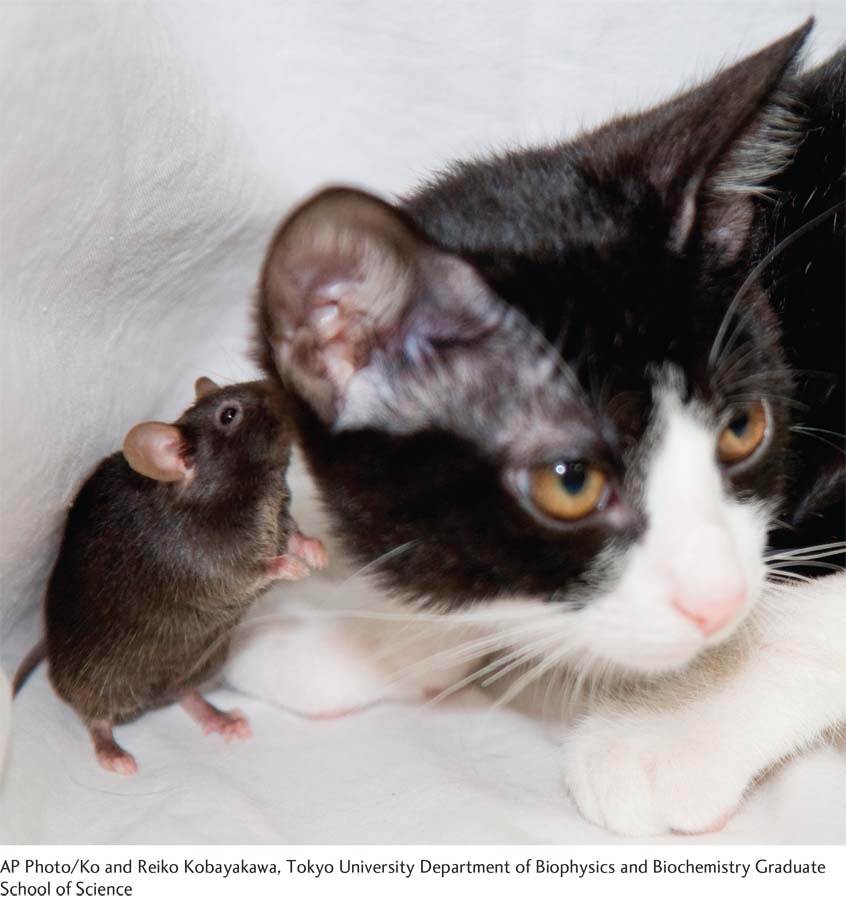
How Have Behavioral Explanations Fared in Research? Some laboratory studies have found that animals and humans can indeed be taught to fear objects through classical conditioning (Miller, 1948; Mowrer, 1947, 1939). In one famous report, psychologists John B. Watson and Rosalie Rayner (1920) described how they taught a baby boy called Little Albert to fear white rats. For weeks Albert was allowed to play with a white rat and appeared to enjoy doing so. One time when Albert reached for the rat, however, the experimenter struck a steel bar with a hammer, making a very loud noise that frightened Albert. The next several times that Albert reached for the rat, the experimenter again made the loud noise. Albert acquired a fear and avoidance response to the rat.
Research has also supported the behavioral position that fears can be acquired through modeling. Psychologists Albert Bandura and Theodore Rosenthal (1966), for example, had human research participants observe a person apparently being shocked by electricity whenever a buzzer sounded. The victim was actually the experimenter’s accomplice—
Although these studies support behaviorists’ explanations of phobias, other research has called those explanations into question (Gamble et al., 2010). Several laboratory studies with children and adults have failed to condition fear reactions. In addition, although most case studies trace phobias to incidents of classical conditioning or modeling, quite a few fail to do so. So, although it appears that a phobia can be acquired by classical conditioning or modeling, researchers have not established that the disorder is ordinarily acquired in this way.
preparedness A predisposition to develop certain fears.
A Behavioral-
A four-
(Marks, 1977, p. 192)
Where might such predispositions to fear come from? According to some theorists, the predispositions have been transmitted genetically through an evolutionary process. Among our ancestors, the ones who more readily acquired fears of animals, darkness, heights, and the like were more likely to survive long enough to reproduce and to pass on their fear inclinations to their offspring (Cherry, 2014; Ohman & Mineka, 2003).
How Are Phobias Treated?
Every theoretical model has its own approach to treating phobias, but behavioral techniques are more widely used than the rest, particularly for specific phobias. In addition, research has shown such techniques to fare better than other approaches in most head-
exposure treatments Behavioral treatments in which persons are exposed to the objects or situations they dread.
Treatments for Specific Phobias Specific phobias were among the first anxiety disorders to be treated successfully. The major behavioral approaches to treating them are systematic desensitization, flooding, and modeling. Together, these approaches are called exposure treatments because in all of them people are exposed to the objects or situations they dread (Gordon et al., 2013; Abramowitz et al., 2011).

systematic desensitization A behavioral treatment that uses relaxation training and a fear hierarchy to help clients with phobias react calmly to the objects or situations they dread.
People treated by systematic desensitization, a technique developed by Joseph Wolpe (1987, 1969), learn to relax while gradually facing the objects or situations they fear. Since relaxation and fear are incompatible, the new relaxation response is thought to substitute for the fear response. Desensitization therapists first offer relaxation training to clients, teaching them how to bring on a state of deep muscle relaxation at will. In addition, the therapists help clients create a fear hierarchy, a list of feared objects or situations, ordered from mildly to extremely upsetting.
Then clients learn how to pair relaxation with the objects or situations they fear. While the client is in a state of relaxation, the therapist has the client face the event at the bottom of his or her hierarchy. This may be an actual confrontation, a process called in vivo desensitization. A person who fears heights, for example, may stand on a chair or climb a stepladder. Or the confrontation may be imagined, a process called covert desensitization. In this case, the person imagines the frightening event while the therapist describes it. The client moves through the entire list, pairing his or her relaxation responses with each feared item. Because the first item is only mildly frightening, it is usually only a short while before the person is able to relax totally in its presence. Over the course of several sessions, clients move up the ladder of their fears until they reach and overcome the one that frightens them most of all.
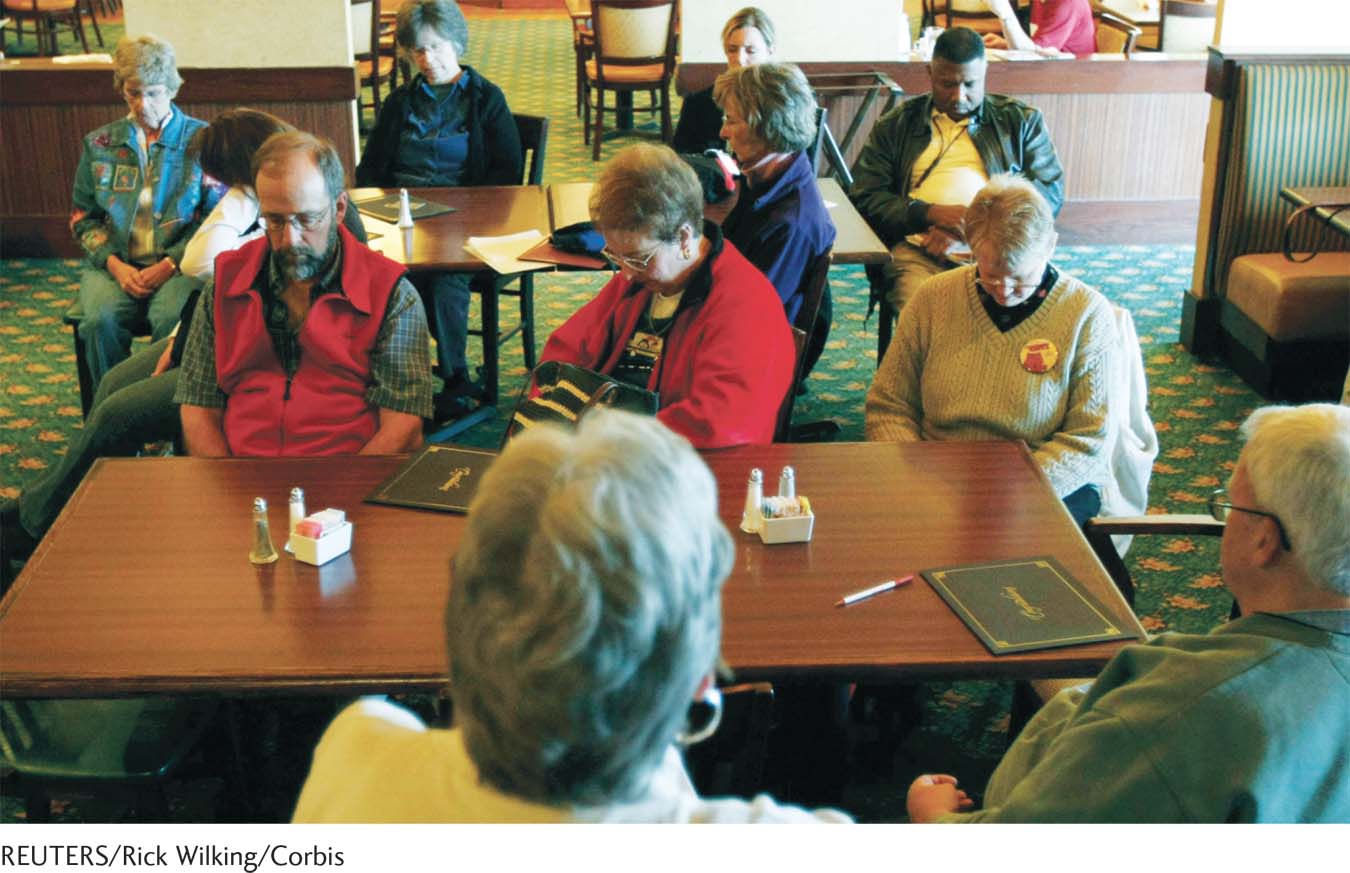
flooding A treatment for phobias in which clients are exposed repeatedly and intensively to a feared object and made to see that it is actually harmless.
Another behavioral treatment for specific phobias is flooding. Therapists who use flooding believe that people will stop fearing things when they are exposed to them repeatedly and made to see that they are actually quite harmless. Clients are forced to face their feared objects or situations without relaxation training and without a gradual buildup. The flooding procedure, like desensitization, can be either in vivo or covert.
When flooding therapists guide clients in imagining feared objects or situations, they often exaggerate the description so that the clients experience intense emotional arousal. In the case of a woman with a snake phobia, the therapist had her imagine the following scene, among others:
BETWEEN THE LINES
Famous Movie Phobias
Number 23 (The Number 23)
Enclosed spaces (The Da Vinci Code)
Bats (Batman Begins)
Spiders (Harry Potter movies)
Snakes (Raiders of the Lost Ark)
Illness (Hannah and Her Sisters)
The outside world (Copycat)
Social situations (Annie Hall)
Social situations (The 40-
Social situations (Coyote Ugly)
Air travel (Rain Man)
Air travel (Red Eye)
Heights (Vertigo)
The color red (Marnie)
Enclosed spaces (Body Double)
Spiders (Arachnophobia)
Close your eyes again. Picture the snake out in front of you, now make yourself pick it up. Reach down, pick it up, put it in your lap, feel it wiggling around in your lap, leave your hand on it, put your hand out and feel it wiggling around. Kind of explore its body with your fingers and hand. You don’t like to do it, make yourself do it. Make yourself do it. Really grab onto the snake. Squeeze it a little bit, feel it. Feel it kind of start to wind around your hand. Let it. Leave your hand there, feel it touching your hand and winding around it, curling around your wrist.
(Hogan, 1968, p. 423)
In modeling it is the therapist who confronts the feared object or situation while the fearful person observes (Bandura, 2011, 1977, 1971; Bandura et al., 1977). The behavioral therapist acts as a model to demonstrate that the person’s fear is groundless. After several sessions many clients are able to approach the objects or situations calmly. In one version of modeling, participant modeling, the client is actively encouraged to join in with the therapist.
Clinical researchers have repeatedly found that each of the exposure treatments helps people with specific phobias (Tellez et al., 2015; Antony & Roemer, 2011). The key to greater success in all of these therapies appears to be actual contact with the feared object or situation. In vivo desensitization is more effective than covert desensitization, in vivo flooding more effective than covert flooding, and participant modeling more helpful than strictly observational modeling. In addition, a growing number of therapists are using virtual reality—3D computer graphics that simulate real-
Treatments for Agoraphobia For years clinicians made little impact on agoraphobia, the fear of leaving one’s home and entering public places. However, approaches have now been developed that enable many people with agoraphobia to venture out with less anxiety. These new approaches do not always bring as much relief to sufferers as the highly successful treatments for specific phobias, but they do offer considerable relief to many people.
BETWEEN THE LINES
Modern Stress and Anxiety Relief: Top Products on the Marketplace
Stress balls/squeeze balls
Stress relief MP3s
Anxiety apps
Soothing candles
Nature sound machines
Nature screen savers
Eye and face masks
Wind chimes
Wind spinners
Natural alarm clocks
Worry beads
Aromatherapy
Behaviorists have again led the way, this time by developing a variety of exposure approaches for agoraphobia (Gloster et al., 2014, 2011). Therapists typically help clients to venture farther and farther from their homes and to gradually enter outside places, one step at a time. Sometimes the therapists use support, reasoning, and coaxing to get clients to confront the outside world. They also use more systematic exposure methods, such as those described in the following case study:
[Lenita] was a young woman who, shortly after she married, found herself unable to leave home. Even walking a few yards from her front door terrified her….
It is not surprising ….hat this young woman found herself unable to function independently after leaving home to marry. Her inability to leave her new home was reinforced by an increasing dependence on her husband and by the solicitous overconcern of her mother, who was more and more frequently called in to stay with her…. Since she was cut off from her friends and from so much enjoyment in the outside world, depression added to her misery….
[After several years of worsening symptoms, Lenita was admitted to our psychiatric hospital.] To measure [her] improvement, we laid out a mile-
This she did, until she was able to stay out for almost half an hour. But was she walking farther each time? Not at all. She was simply circling around in the front drive of the hospital, keeping the “safe place” in sight at all times. We therefore changed the reinforcement to reflect the distance walked. Now she began to walk farther and farther each time. Supported by this simple therapeutic procedure, the patient was progressively able to increase her self-
Praise was then thinned out, but slowly, and the patient was encouraged to walk anywhere she pleased. Five years later, she [is] still perfectly well. We might assume that the benefits of being more independent maintained the gains and compensated for the loss of praise from the therapist.
(Agras, 1985, pp. 77–
Exposure therapy for people with agoraphobia often includes additional features—
Between 60 and 80 percent of agoraphobic clients who receive exposure treatment find it easier to enter public places, and the improvement persists for years after the beginning of treatment (Craske & Barlow, 2014; Gloster et al., 2014, 2011). Unfortunately, these improvements are often partial rather than complete, and as many as half of successfully treated clients have relapses, although these people readily recapture previous gains if they are treated again. Those whose agoraphobia is accompanied by a panic disorder seem to benefit less than others from exposure therapy alone. We shall take a closer look at this group when we investigate treatments for panic disorder.
Summing Up
PHOBIAS A phobia is a severe, persistent, and unreasonable fear of a particular object, activity, or situation. There are two main categories of phobias: specific phobias and agoraphobia. Behaviorists believe that phobias are often learned from the environment through classical conditioning or through modeling, and then are maintained by avoidance behaviors.
Specific phobias have been treated most successfully with behavioral exposure techniques by which people are led to confront the objects they fear. The exposure may be gradual and relaxed (desensitization), intense (flooding), or vicarious (modeling). Agoraphobia is also treated effectively by exposure therapy. However, for people with both agoraphobia and panic disorder, exposure therapy alone is not as effective.